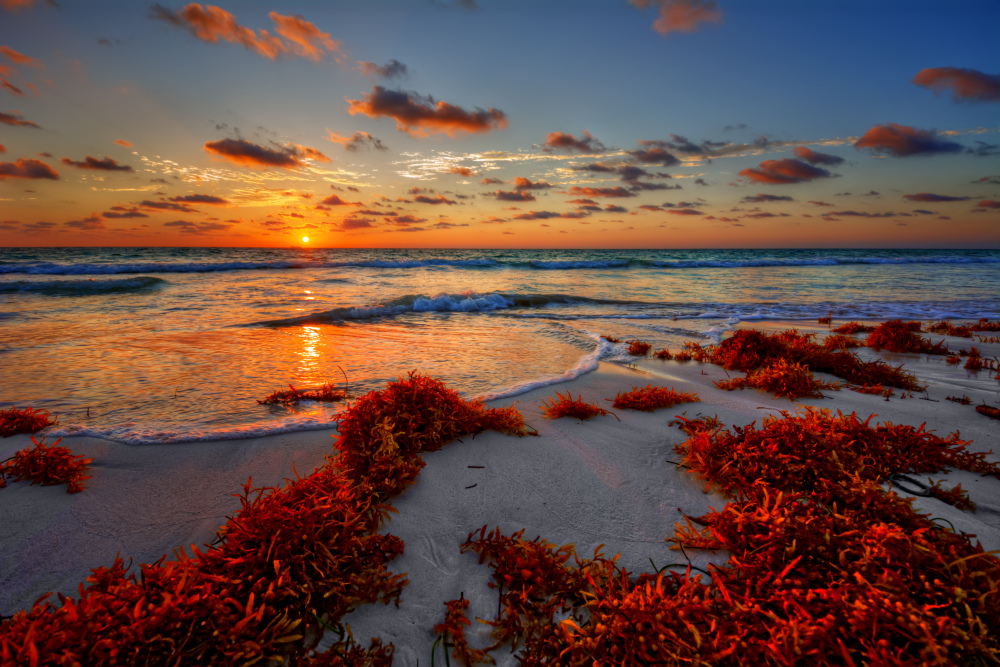Seaweed is Good Goo
- January 13, 2015
- By Robin Koontz

What’s that slimy stuff on the beach that squishes between your toes? Hopefully it’s seaweed. Seaweed is actually a common name for thousands of species of rootless marine plants and algae that grow in all forms of water bodies. Red and brown seaweeds grow mostly in salt water and green seaweeds grow primarily in fresh water. Seaweed is one of the oldest forms of marine life.
It’s not really fair to call seaweed a weed; since that word implies a plant that can grow so fast and furious it can harm its habitat. Some seaweed can get out of control, such as the damages caused by “harmful algal blooms” (HABs). But seaweed is vital to life on our planet. So I’ll focus on the good goo for this article. You might want to ask your students to research HABs and discover ideas on how and why there seems to be an increase of blooms in recent years.
Single-cell algae in the ocean produce about half the total oxygen on Earth. Seaweed is also essential to the survival of marine creatures for food and habitat. Seaweed washed up on beaches feeds birds, crustaceans, and other wildlife. People have been also been devouring seaweed for thousands of years! It is used in Asian as well as Irish, Welsh and Scottish cooking. Sushi rolls, which are seaweed with raw fish and rice, are one of the most popular foods in Japan and other parts of the world.
It’s true. That slimy seaweed can be good for you! The plants are full of vitamins, minerals, and fiber as well as anti-inflammatory and anti-microbial agents. There is evidence that the ancient Romans used seaweed to treat wounds and rashes. The Chinese also used seaweed for medical treatments, including cancer. In more recent years, scientists have discovered that certain seaweeds really do have powerful cancer-fighting agents. To note, there is a very low rate of cancer in Japan. Dietary soy used to get credit for that, but now it appears that seaweed has something to do with their good health as well.
While you’d have to consume a lot of seaweed to get your daily dosage of vitamins, the iodine factor is a big plus. Most people don’t get enough iodine. Even though the World Health Organization promoted a worldwide salt iodization program in 1993, most processed foods (while usually overloaded with salt) use iodine-free sodium. Iodine deficiency is becoming common again. But just one gram of brown seaweed has more than enough of the recommended daily recommendation of iodine for the day. Be careful though, because too much seaweed can provide more potassium than some people can handle.
Seaweed also has multiple uses in manufacturing. Composted seaweed has been used for hundreds of years as natural fertilizer and soil conditioner. Seaweed that has been burned produces an alkaline ash consisting of soda and potash. It has been used in glassware and glazing industries and even to make soap. Neptune’s balls, dead seagrass that rolls into balls, are gathered from beaches in the Mediterranean and used for insulation.
Scientists discovered that some seaweed species contained molecules that had the ability to thicken just about any liquid. These hydrocolloids serve as binding agents in products such as toothpaste and shampoo. The concoction also helps make Jell-O jiggle and ice cream stay creamy. There are close to 55,000 metric tons of hydrocolloids extracted from seaweed each year for a variety of uses. Seaweed’s ability to filter water makes is useful as a means to extract toxins from wastewater. Seaweed’s photosynthesis process can extract out potentially harmful nitrate, nitrite, phosphate, ammonia, ammonium, iron, and copper from our water supplies.
Seaweed can be grown just about anyplace in the world, even in frigid sub-arctic waters. An estimated 8 million metric tons of seaweed are harvested worldwide each year. About 90% of it is cultivated, not taken from the wild. It’s a complicated process, done either using low-tech methods or high-tech large-scale production. One low-tech, centuries-old method is the use of “kelp ropes.” In China, Kelp zoospores attach themselves to seedling cords that are placed in containers with seawater. Once they are the right maturity, the juvenile plants are inserted every few inches into twists of the kelp rope. The ropes float in the sea with buoys, anchored so that the ropes can’t float away. Once the kelp fronds are mature, they are harvested from boats. You can download some interesting photographs of the process here: http://www.seaweed.ie/aquaculture/kelp_china.php
Activities:Make your own Seaweed Goo!
Small cups
Fresh water
Stir sticks
Measuring spoons
Paper towels
Powdered seaweed (available in most grocery stores, usually in the Asian food section – often called alginate)
Put about a tablespoon of water in a cup. Add about 1/4 teaspoon of powered seaweed and stir. Use the activity to talk about how seaweed makes pudding, mayonnaise, and other liquid products creamer or thicker.
Now students can read labels at home (or you can generously bring in a variety of products) to see how much seaweed they are using or eating. The key words to look for are agar, algin, alginate, and carrageenan.
Hint: the author found seaweed ingredients in cat food and ice cream.

Kids Discover Talks with Television Lighting Designer Christopher Landy About the Rockefeller Center Christmas Tree Lighting
- December 9, 2025

It’s the Most Wonderful Time of the Year… For Community Service Projects!
- December 8, 2025

The Rockefeller Center Christmas Tree Lights the 2025 Holiday Season in New York City
- December 3, 2025